HOW TO: Add an iSCSI Software Adaptor and Create an iSCSI Multipath Network in VMware vSphere Hypervisor ESXi 5.0
EE Fellow, MVE, Expert of the Year 2021,2017-11, Scribe 2016-2012, Author of the Year 2018-6,2013-2012 VMware vExpert Pro, vExpert 2022-2011
Published:
Browse All Articles > HOW TO: Add an iSCSI Software Adaptor and Create an iSCSI Multipath Network in VMware vSphere Hypervisor ESXi 5.0
Using a software based iSCSI solution, there is no requirement to purchase a hardware iSCSI initiator or TOE (TCP/IP Offload Engine) interface card. A standard network interface card can be used to connect an existing ESXi server to a remote iSCSI target or iSCSI SAN on the TCP/IP storage network. The iSCSI Software Adapter built into the VMKenerl interface, completes the communication between the network interface card and the host server network stack.
This tutorial can be used to add an iSCSI Software Adapter and create an iSCSI Multipath Network in VMware vSphere Hypervisor ESXi 5.0, using the new Network Configuration iSCSI Bindings option in the vSphere Client GUI. In older versions of ESX/ESXi bindings needed to be completed at the command line.
Using the VMware vSphere Client, login and connect to the ESXi 5.0 server, using IP address or hostname of the ESXi 5.0 server, using root username and password credentials. If you have a VMware vSphere vCenter server, you could also specify IP address or hostname of the vCenter server which manages your vSphere 5 ESXi 5.0 server.
![Using the VMware vSphere Client, login and connect to the ESXi 5.0 server]()
When connected to the ESXi server, select the Host Server, Configuration tab, and select Storage Adapters. Please note, if you do not have any persistent storage connected to the ESXi server, a yellow warning configuration box will appear. This example server used in this tutorial does not have any local SAS or SATA storage connected. Once the iSCSI Software Adapter has been added, iSCSI storage can be added, and this yellow warning configuration box will disappear.
![Storage Adaptors iSCSI software Adaptor not visible]()
Click Add in Storage Adapters
![Select Add Software iSCSI Adapter and Click OK]()
Select Add Software iSCSI Adapter and Click OK. The following prompt will be displayed.
![Software iSCSI Adapter added]()
Select iSCSI Software Adapter, and Select Properties
![Select iSCSI Software Adaptor, and Select Properties]()
The iSCSI Initiator (vmba33) Properties dialogue page will appear. Note that Software Initiator Properties should be Enabled, and the iSCSI Properties Name is now populated with an iSCSI Initiator Name.
![iSCSI Initiator (vmba33) Properties]()
In this example the iSCSI initiator name is
iqn.1998-01.com.vmware:esxdev008-2a5d8616
The iSCSI initiator adapter name is vmba33.
Please record both the iSCSI Initiator Name and the adapter name, these will be important for you in the future, it will be needed when you assign storage to this initiator. The adapter name is required later in this procedure to complete VMKernel bindings.
Click Close to proceed.
The VMKernel TCP/IP stack Portgroup handles traffic for the following ESXi services iSCSI, NFS, VMware vMotion and host management. To create a multipath iSCSI network at least two VMKernel TCP/IP stack Portgroups needed to be created on a virtual switch.
Select the Host Server, Configuration tab, and select Networking.
![Add new vSwitch]()
Select Add Networking to add a new vSwitch (virtual switch). Select VMKernel followed by Next
![Add Networking Wizard]()
Create a new virtual switch with at least two physical network interfaces connections for use with multipath. I've selected vmnic2 and vmnic3, followed by Next.
![new virtual switch]()
Enter a network friendly network label for the VMkernel iSCSI Portgroup 1 - VMkernel iSCSI Network 1, followed by Next
![VMkernel Connection Settings]()
Enter an IP address for the first VMkernel iSCSI Portgroup 1, followed by Next
![VMkernel - IP Connecting Settings]()
Review the vSwitch configuration is correct and click Finish
![Review the vSwitch configuration]()
Review the vSwitch created
![New vSwitch1 created]()
Select Properties of the vSwitch and Click Add
![vSwitch1 Properties]()
Add another VMkernel Portgroup, Select VMKernel followed by Next
![Add Networking Wizard]()
Enter a network friendly network label for the VMkernel iSCSI Portgroup 2 - VMkernel iSCSI Network 2, followed by Next
![VMkernel Connection Settings]()
Enter an IP address for the first VMkernel iSCSI Portgroup 2, followed by Next
![VMkernel - IP Connecting Settings]()
Review the vSwitch configuration is correct and click Finish and Close.
![Review the vSwitch configuration]()
Review the Final vSwitch created, with two VMkernel Portgroups
![vSwitch1 complete with two VMkernel Portgroups]()
The two VMkernel portgroups have been added, and the vSwitch configuration is almost complete.
In this section we need to override the switch failover order for each VMkernel portgroup as follows
VMkernel iSCSI Network 1 - Active Network interface vmnic2 - Unused Network Interface vmnic3
VMkernel iSCSI Network 2 - Active Network interface vmnic3 - Unused Network Interface vmnic2
Select Properties of the vSwitch created in Step 4.
![vSwitch1 complete with two VMkernel Portgroups]()
vSwitch1 properties will be displayed. Select the VMkernel iSCSI Network 1 portgroup to edit
![edit VMkernel portgroup]()
Select NIC Teaming
![Select NIC Teaming]()
Select and put a tick in Override vSwitch Failover order and select the network interface e.g. vmnic3 to move down to Unused adapters
![vSwitch Override]()
This is how override vSwitch failover should look for VMkernel iSCSI Network 1
![vSwitch Override for VMkernel iSCSI Network 1]()
Click OK. We now need to repeat the same steps for VMkernel iSCSI Network 2 Select the VMkernel iSCSI Network 2 portgroup to edit
![vSwitch Override for VMkernel iSCSI Network 2]()
Select NIC Teaming
![Select NIC Teaming]()
Select and put a tick in Override vSwitch Failover order and select the network interface e.g. vmnic2 to move down to Unused adapters
![vSwitch Override for VMkernel iSCSI Network 2]()
This is how override vSwitch failover should look for VMkernel iSCSI Network 2
![vSwitch Override for VMkernel iSCSI Network 2]()
Click OK, followed by close, override vSwitch failover has been completed for the vSwitch. VMKernels are now bound to specific network interfaces, as follows
VMkernel iSCSI Network 1 - Active Network interface vmnic2 - Unused Network Interface vmnic3
VMkernel iSCSI Network 2 - Active Network interface vmnic3 - Unused Network Interface vmnic2
The final and remaining step is to bind these with the software iSCSI initiator (adapter). The The iSCSI Initiator adapter name is vmba33. (from Step 3).
.
This step is often forgotten, and DID require the login to the console or remotely via SSH to the ESXi server. The VMware vSphere CLI can also be used with the esxcli.exe command to set the bindings if you prefer to use the vSphere CLI. Traditionally with ESXi 4.1, you could use the esxcli swiscsi commands at the console or via SSH.
In ESXi 5.0 this can now be performed from the VMware vSphere Client as follows
Select Storage Adapters
![Storage Adaptors iSCSI software Adaptor not visible]()
Select iSCSI Software Adapter, and Select Properties
![Select iSCSI Software Adaptor, and Select Properties]()
The iSCSI Initiator (vmba33) Properties dialogue page will appear. Select the Network Configuration tab.
![iSCSI Initiator (vmba33) Properties]()
The iSCSI Initiator Networking Configuration and binding page will open.
![iSCSI Initiator Networking Configuration]()
Click Add
![Click Add]()
The Bind with VMkernel Network Adapter page will appear. Select VMkernel iSCSI Network 1 and Click OK
![Bind with VMkernel Network Adapter page]()
This will complete the binding of VMkernel iSCSI Network 1 (vmk1) to vmnic2.
![VMkernel iSCSI Network 1 (vmk1) to vmnic2.]()
Click Add to complete the bindings for VMkernel iSCSI Network 2 (vmk2) to vmnic3. Select VMkernel iSCSI Network 2 and Click OK
![VMkernel iSCSI Network 2 (vmk2) to vmnic3]()
Review the Final iSCSI Initiator Bindings and click Close.
![Final Bindings]()
Click close and select Yes, when prompted to Rescan the Adapter.
You have added an iSCSI Software Adapter and Created an iSCSI Multipath network for your iSCSI storage.
*******************************************************************************************************************************************
Thank you for reading my article, please leave valuable feedback. If you liked my VMware article and would like to see more VMware Articles from me, please click the Yes button near the: Was this article helpful? at the Top of this article to the right of the Article title. Thank You.
*******************************************************************************************************************************************
This tutorial can be used to add an iSCSI Software Adapter and create an iSCSI Multipath Network in VMware vSphere Hypervisor ESXi 5.0, using the new Network Configuration iSCSI Bindings option in the vSphere Client GUI. In older versions of ESX/ESXi bindings needed to be completed at the command line.
1. Connect to the VMware vSphere Hypervisor (ESXi 5.0) Server
Using the VMware vSphere Client, login and connect to the ESXi 5.0 server, using IP address or hostname of the ESXi 5.0 server, using root username and password credentials. If you have a VMware vSphere vCenter server, you could also specify IP address or hostname of the vCenter server which manages your vSphere 5 ESXi 5.0 server.
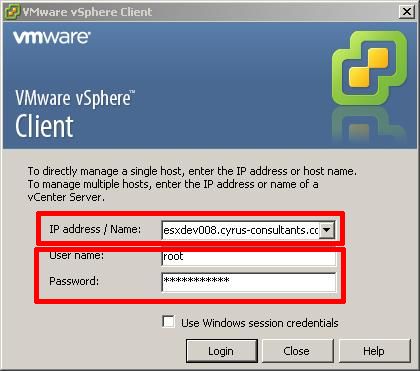
2. Select and Configure the Storage Adapters for the ESXi 5.0 server
When connected to the ESXi server, select the Host Server, Configuration tab, and select Storage Adapters. Please note, if you do not have any persistent storage connected to the ESXi server, a yellow warning configuration box will appear. This example server used in this tutorial does not have any local SAS or SATA storage connected. Once the iSCSI Software Adapter has been added, iSCSI storage can be added, and this yellow warning configuration box will disappear.
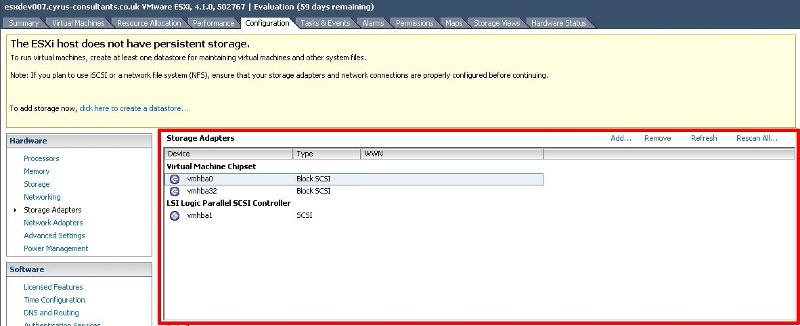
3. Adding and Configuring the iSCSI Software Adapter using the vSphere Client version 5.0.0
Click Add in Storage Adapters

Select Add Software iSCSI Adapter and Click OK. The following prompt will be displayed.

Select iSCSI Software Adapter, and Select Properties

The iSCSI Initiator (vmba33) Properties dialogue page will appear. Note that Software Initiator Properties should be Enabled, and the iSCSI Properties Name is now populated with an iSCSI Initiator Name.

In this example the iSCSI initiator name is
iqn.1998-01.com.vmware:esx
The iSCSI initiator adapter name is vmba33.
Please record both the iSCSI Initiator Name and the adapter name, these will be important for you in the future, it will be needed when you assign storage to this initiator. The adapter name is required later in this procedure to complete VMKernel bindings.
Click Close to proceed.
4. Create a new vSwitch (virtual switch) and add VMKernel Portgroups
The VMKernel TCP/IP stack Portgroup handles traffic for the following ESXi services iSCSI, NFS, VMware vMotion and host management. To create a multipath iSCSI network at least two VMKernel TCP/IP stack Portgroups needed to be created on a virtual switch.
Select the Host Server, Configuration tab, and select Networking.

Select Add Networking to add a new vSwitch (virtual switch). Select VMKernel followed by Next
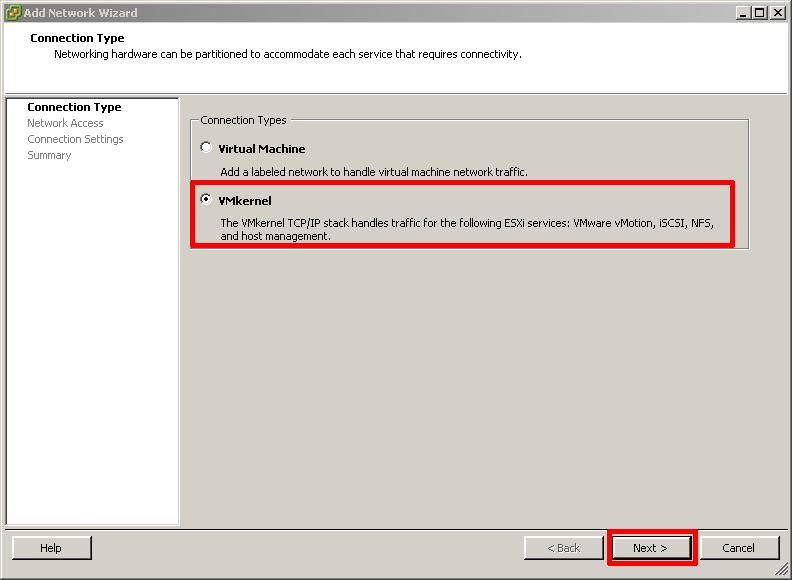
Create a new virtual switch with at least two physical network interfaces connections for use with multipath. I've selected vmnic2 and vmnic3, followed by Next.

Enter a network friendly network label for the VMkernel iSCSI Portgroup 1 - VMkernel iSCSI Network 1, followed by Next

Enter an IP address for the first VMkernel iSCSI Portgroup 1, followed by Next

Review the vSwitch configuration is correct and click Finish
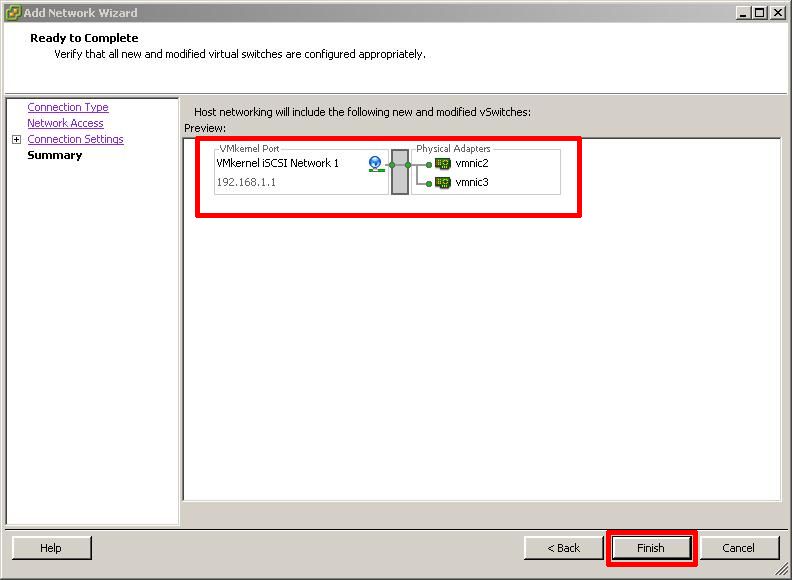
Review the vSwitch created

Select Properties of the vSwitch and Click Add
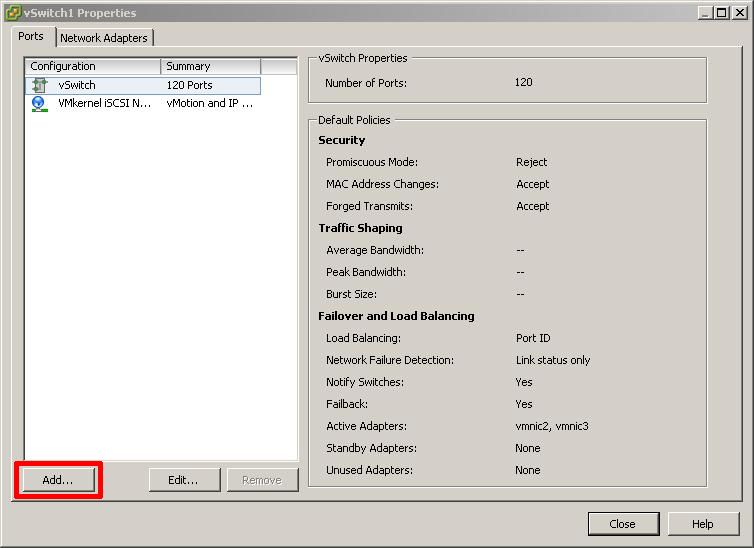
Add another VMkernel Portgroup, Select VMKernel followed by Next

Enter a network friendly network label for the VMkernel iSCSI Portgroup 2 - VMkernel iSCSI Network 2, followed by Next

Enter an IP address for the first VMkernel iSCSI Portgroup 2, followed by Next
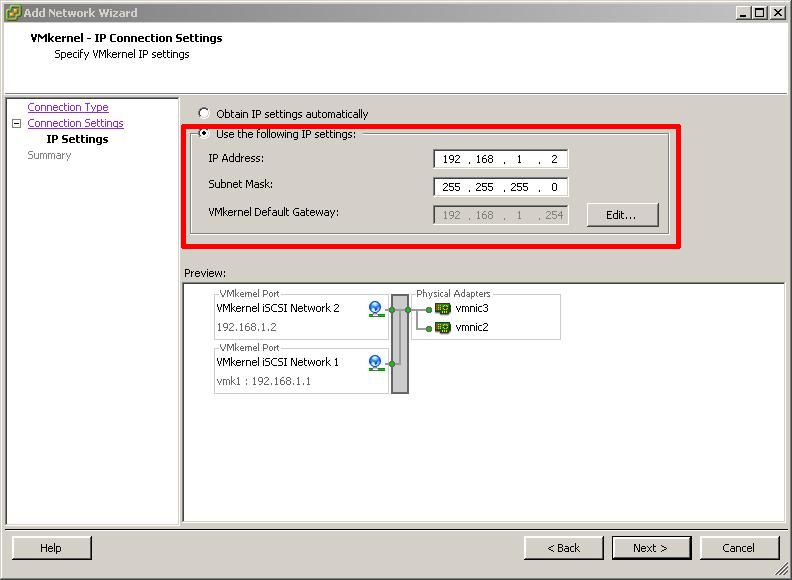
Review the vSwitch configuration is correct and click Finish and Close.

Review the Final vSwitch created, with two VMkernel Portgroups

The two VMkernel portgroups have been added, and the vSwitch configuration is almost complete.
5. VMkernel Portgroup - Override vSwitch failover order
In this section we need to override the switch failover order for each VMkernel portgroup as follows
VMkernel iSCSI Network 1 - Active Network interface vmnic2 - Unused Network Interface vmnic3
VMkernel iSCSI Network 2 - Active Network interface vmnic3 - Unused Network Interface vmnic2
Select Properties of the vSwitch created in Step 4.

vSwitch1 properties will be displayed. Select the VMkernel iSCSI Network 1 portgroup to edit
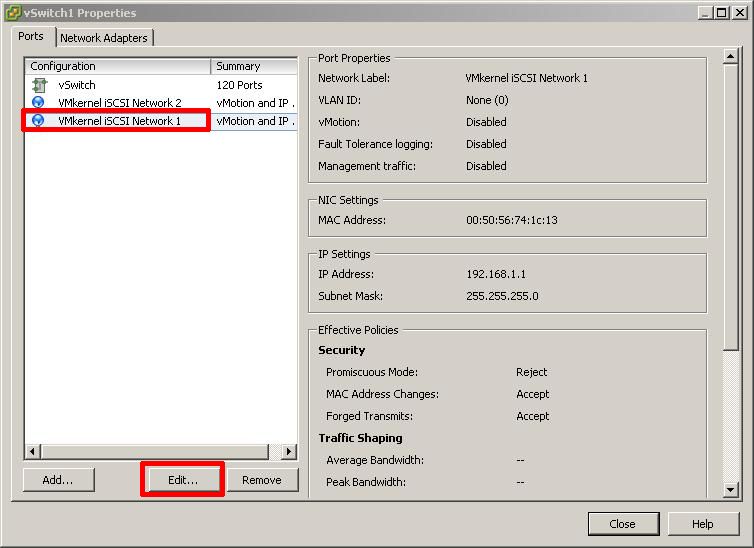
Select NIC Teaming
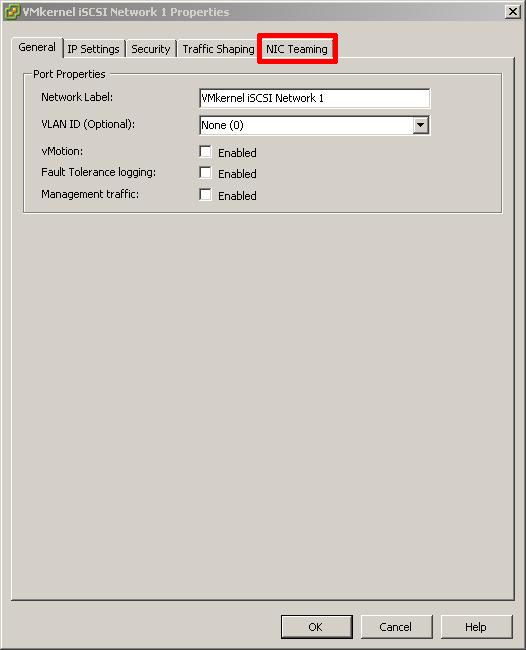
Select and put a tick in Override vSwitch Failover order and select the network interface e.g. vmnic3 to move down to Unused adapters
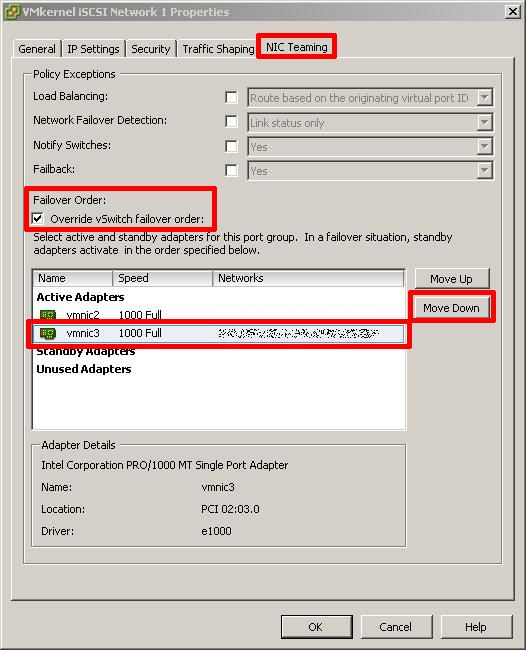
This is how override vSwitch failover should look for VMkernel iSCSI Network 1

Click OK. We now need to repeat the same steps for VMkernel iSCSI Network 2 Select the VMkernel iSCSI Network 2 portgroup to edit

Select NIC Teaming

Select and put a tick in Override vSwitch Failover order and select the network interface e.g. vmnic2 to move down to Unused adapters
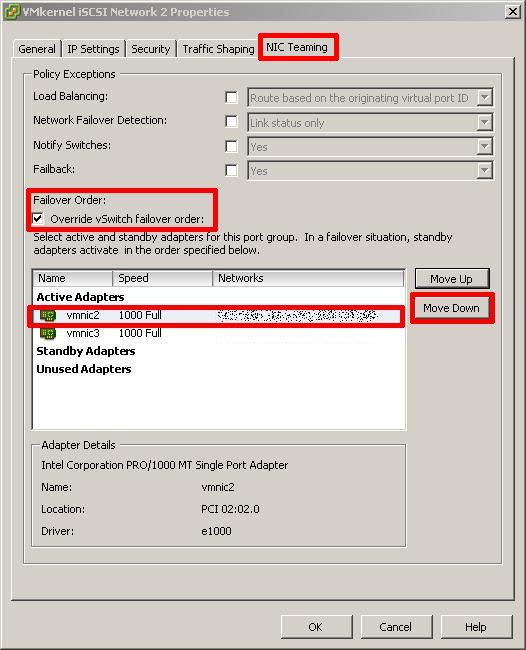
This is how override vSwitch failover should look for VMkernel iSCSI Network 2
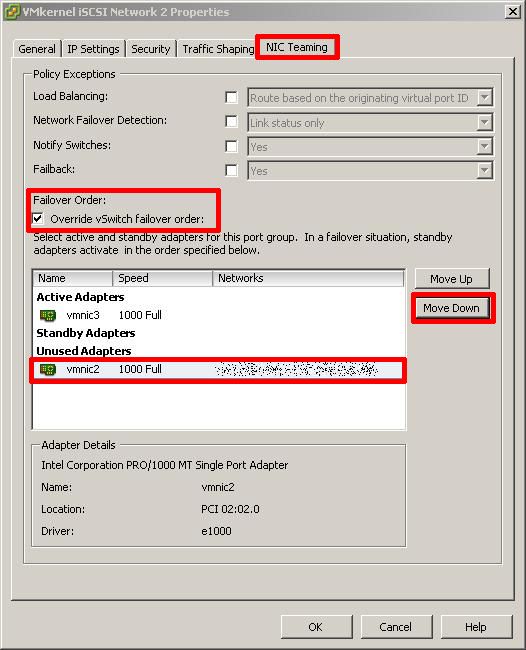
Click OK, followed by close, override vSwitch failover has been completed for the vSwitch. VMKernels are now bound to specific network interfaces, as follows
VMkernel iSCSI Network 1 - Active Network interface vmnic2 - Unused Network Interface vmnic3
VMkernel iSCSI Network 2 - Active Network interface vmnic3 - Unused Network Interface vmnic2
The final and remaining step is to bind these with the software iSCSI initiator (adapter). The The iSCSI Initiator adapter name is vmba33. (from Step 3).
.
6. Bind physical network interfaces (pNIC) to the iSCSI VMKernel
This step is often forgotten, and DID require the login to the console or remotely via SSH to the ESXi server. The VMware vSphere CLI can also be used with the esxcli.exe command to set the bindings if you prefer to use the vSphere CLI. Traditionally with ESXi 4.1, you could use the esxcli swiscsi commands at the console or via SSH.
In ESXi 5.0 this can now be performed from the VMware vSphere Client as follows
Select Storage Adapters

Select iSCSI Software Adapter, and Select Properties

The iSCSI Initiator (vmba33) Properties dialogue page will appear. Select the Network Configuration tab.

The iSCSI Initiator Networking Configuration and binding page will open.
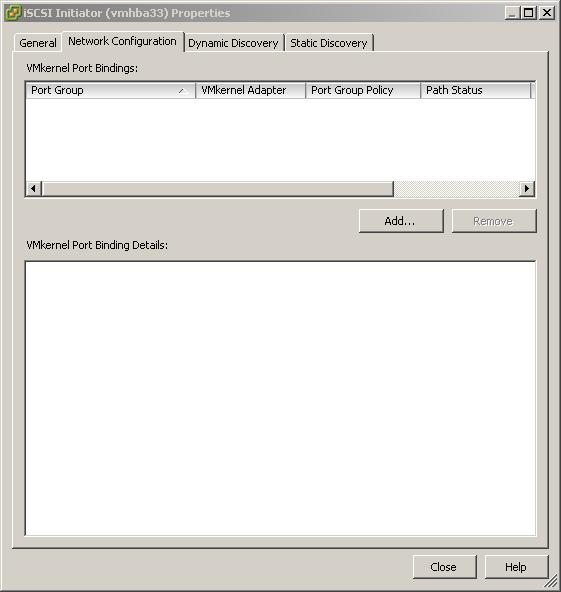
Click Add

The Bind with VMkernel Network Adapter page will appear. Select VMkernel iSCSI Network 1 and Click OK
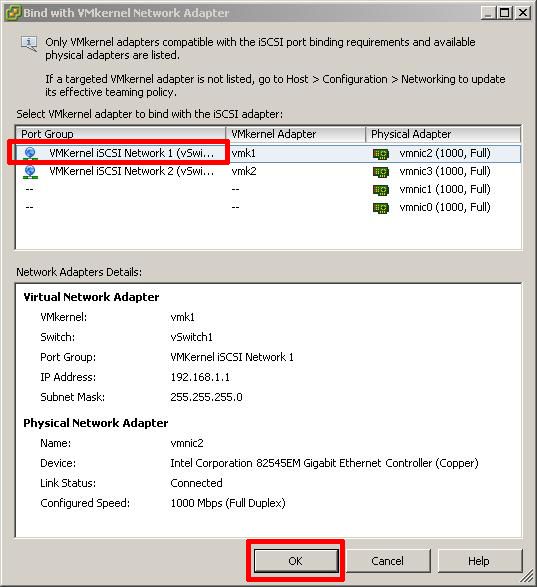
This will complete the binding of VMkernel iSCSI Network 1 (vmk1) to vmnic2.

Click Add to complete the bindings for VMkernel iSCSI Network 2 (vmk2) to vmnic3. Select VMkernel iSCSI Network 2 and Click OK

Review the Final iSCSI Initiator Bindings and click Close.

Click close and select Yes, when prompted to Rescan the Adapter.
You have added an iSCSI Software Adapter and Created an iSCSI Multipath network for your iSCSI storage.
**************************
Thank you for reading my article, please leave valuable feedback. If you liked my VMware article and would like to see more VMware Articles from me, please click the Yes button near the: Was this article helpful? at the Top of this article to the right of the Article title. Thank You.
**************************
Have a question about something in this article? You can receive help directly from the article author. Sign up for a free trial to get started.


Comments (8)
Commented:
Author
Commented:Commented:
Author
Commented:Thanks for your kind words.
Andy
Commented:
View More